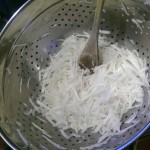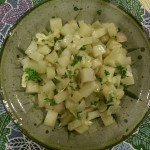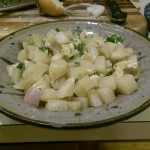March is National Nutrition Month and we’re publishing a series of blog posts that focus on nutrition within our networks. You can also learn about our programs here.
We’ve got two recipes for turnips from our Vermont Fresh: A Fruit and Vegetable Handbook, Turnip Hash and Turnip Frittata. Also, we have tips for turnip growing, storage and cooking.
Kate Whelley McCabe, a volunteer cooking, tasting and testing recipes out of the Vermont Fresh Handbook tested the recipes. Her comments are below in italics.
Background
The turnip is an ancient root vegetable whose cultivation most likely predates Greek civilization. Because turnips are very hardy, are easy to grow, and provide a substantial amount of food, they were a reliable staple crop throughout Europe long before the potato. While smaller, more tender turnip varieties are cultivated for human consumption, larger types of turnips are grown as animal fodder. A member of the Brassica family, turnips are related to mustards, kale, broccoli, and cabbage, among other vegetables. Though turnips are best known for their roots, their greens are also edible and are highly nutritious.
Growing Tips
Turnips are fairly cold-tolerant and can be directly seeded in early spring. Sow seeds about ¾-inch deep in loose, fertile soil and thin seedlings to have about 2 – 4 inches of space. Keep an eye on seedlings for signs of flea beetles and cover with row cover if necessary. Baby turnips will be ready in around 30 days, they will take almost twice as long to reach full size. You can sow seeds every few weeks for a continuous supply, but beware, turnips will be best in the spring and fall when temperatures are a little cooler. In fact, they are sweetest after a fall frost. The plants should be watered plentifully and often. Most varieties are ready for harvest when the roots reach about 3-4 inches in size. All turnips should be pulled before consistently freezing days set in. Greens can be harvested throughout the growing period, but be sure to leave a few leaves on each plant.
Storage
Remove green to retain nutrient value. Turnips will store in your crisper drawer for several weeks, with roots loosely in plastic. If you have a root cellar, trying storing them there as you would with carrots. Like many roots, turnips like it cool and dark without excessive humidity. If greens are young and tender you can eat these as well, either raw or braised; store in plastic similar to other greens.
Nutritional Benefits
Turnips roots are a good source of both fiber and Vitamin C. The greens are surprisingly nutritious as well, containing Vitamins A and K in addition to C. They also deliver the minerals calcium and lutein. Calcium helps to build strong bones and lutein is believed to support eye and skin health.
Preparation
Always give your turnips a good scrub before using them. Smaller turnips tend to be fairly tender and are tasty eaten raw, while large turnips have a more woody texture and lend themselves more to cooking. Turnips can be baked, boiled, mashed, sautéed, or steamed. Because they can be slightly bitter, turnips are often served with other vegetables or spices. Most other root vegetables complement turnips well.
Meatless Monday Turnip Frittata
- Photo courtesy of Kate Whelley McCabe
- Photo courtesy of Kate Whelley McCabe
Serves 6
(adapted from Martha Rose Shulman: nytimes.com)
Ingredients
- 1 pound small-medium turnips
- 2 teaspoons salt
- 2 tablespoons olive oil
- 2 teaspoons chopped thyme (optional)
- 6 eggs
- 1 tablespoon milk
- ½ teaspoon pepper
- 1 teaspoon minced garlic
- ½ cup pitted, halved black olives (optional)
- ½ cup mushrooms, chopped (optional)
Instructions
- Peel the turnips and roughly grate them. In a colander, toss with some of the salt, and allow to sit for 30 minutes. Then, squeeze out excess water.
- Heat 1 tablespoon olive oil over medium heat in a skillet. Add turnips and thyme and sauté a few minutes. Turn heat to low, add a splash of water, cover, and cook about 15 minutes, stirring frequently. Remove from heat.
- Preheat your oven on the broiler setting.
- Beat the eggs and milk together in a bowl. Add pepper and remaining salt, then stir in olives, mushrooms, and cooked turnips.
- In a heavy, oven-safe, non-stick skillet, heat the rest of the olive oil over medium-high heat. Dump in the egg mixture and swirl around gently to distribute.
- Turn heat very low, cover, and let cook for a few minutes. Then, uncover and transfer the skillet to the oven.
- Allow to cook until completely set, 3-5 minutes longer. Remove from oven, cut into slices as you would a pie, and serve while hot.
The Turnip Fritatta:
- can be made for between 5 and 10 dollars depending on quality of ingredients and whether you add optional ingredients
- recipe took 55 minutes
- was too salty; I would omit adding the second teaspoon of salt, especially if adding olives
Meatless Monday Recipe: Turnip Hash
- Photo courtesy of Kate Whelley McCabe
Serves 4
(adapted from www.petesgreens.blogspot.com)
Ingredients
- 4 tablespoons olive oil
- 1 medium onion, diced
- 1 pound turnips, diced
- 2 cups chicken or vegetable stock
- 2 tablespoons butter
- ½ cup grated gruyere or parmesan cheese
- salt and pepper to taste
- 1 handful of parsley, coarsely chopped (optional)
Instructions
- Heat the olive oil in a skillet over medium heat. Add the onion and cook until translucent, about 5-10 minutes.
- Meanwhile, heat the stock in a separate pot over medium heat.
- Add the turnips to the onions and cook another 3 minutes. Pour in the hot stock and cook until almost completely absorbed.
- Remove mixture from heat and add butter and cheese. Add salt and pepper to taste, garnish with parsley, and serve warm.
The Turnip Hash:
- can be made for between 5 and 10 dollars depending on quality of ingredients
- recipe took 20-25 minutes
- tasted good, but I would cook for shorter period of time for better consistency
- kids and husband neutral on this one
To receive more recipes and tips on your favorite fruits and vegetables, download Vermont Fresh: A Fruit and Vegetable Handbook. We also need more volunteer home chefs for this project.
Vermont Foodbank fresh food initiatives would not be possible without your support. Please consider giving to the Vermont Foodbank today!





